Come Hell or High Water
The Saving of a
Naval Treasure
by Bob Brooke
The cruiser Olympia has survived wars,
decommissioning, decades of neglect, a failed fundraising campaign, an
unsuccessful search for a new home, and plans for an intentional
sinking, or “reefing,” to serve as habitat for marine life.
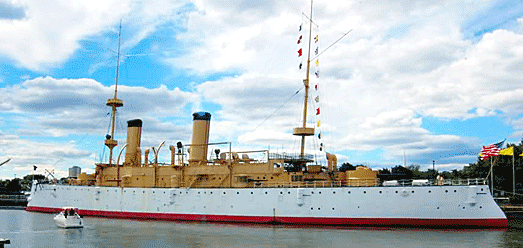
After 124 years afloat, the former flagship of Commodore George Dewey
outwardly looks great. As the last ship of the United States’ “Steel
Navy,” she saw the U.S. Navy’s rebirth and debut as a maritime force.
The hull of the 5,500-ton, 344-foot cruiser shines brilliant white with
a red-striped waterline, buff-colored topside, and knife-like bow for
ramming enemy ships. The interior is ship-shape for a vessel her age.
The Launching of the USS Olympia
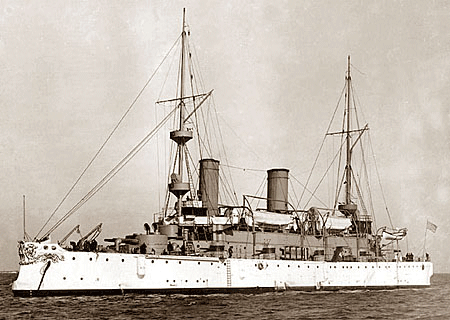 The
Olympia began life as Cruiser Number 6, a 20-knot warship that was
projected to cost no more than $1.8 million. The newly formed U.S. Board
on the Design of Ships began the design process in 1889, and less than a
year later the U.S. Navy solicited bids for the construction of the
ship. Surprisingly, only one firm, the Union Iron Works in San
Francisco, bid on the job. The
Olympia began life as Cruiser Number 6, a 20-knot warship that was
projected to cost no more than $1.8 million. The newly formed U.S. Board
on the Design of Ships began the design process in 1889, and less than a
year later the U.S. Navy solicited bids for the construction of the
ship. Surprisingly, only one firm, the Union Iron Works in San
Francisco, bid on the job.
Commodore George Dewey’s flagship USS Olympia has since found a home in
Philadelphia. The keel of Cruiser Number 6 was laid in June 1891, and
the U.S. Navy launched the ship on November 5, 1892. While her primary
construction occurred in San Francisco, the Carnegie Steel Company of
Pittsburgh, Pennsylvania, fabricated her heavy armor plating.
After sea trials in December 1891 in the Santa Barbara Channel, the USS
Olympia received her commission in February 1895, and slid down the
gangways on November 1892, eight years after the U.S. Navy’s first ships
with steel, not iron, hulls had been launched. She then steamed to the
U.S. Navy’s Mare Island Naval Shipyard at Vallejo, California, for
outfitting.
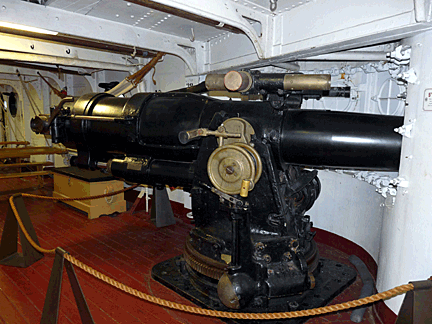 A
protected cruiser, with an armored deck that sloped down to the
waterline to shield machinery and interior compartments, she was among a
group of fast, big, and powerful warships that gave the fledgling Steel
Navy an offensive capability. A
protected cruiser, with an armored deck that sloped down to the
waterline to shield machinery and interior compartments, she was among a
group of fast, big, and powerful warships that gave the fledgling Steel
Navy an offensive capability.
Named for the capital of the new state of Washington, the Olympia had
full gun turrets forward and aft that could rotate 137 degrees. Twin
8-inch Mark III guns protruded in each. Additionally, she bristled with
10 5-inch Mark II guns, 14 6-pounders, 6 1-pounders, 2 Colt machine
guns, and 6 18-inch Whitehead above-surface torpedo tubes. Experts felt
the ship’s armament was excessive for her size.
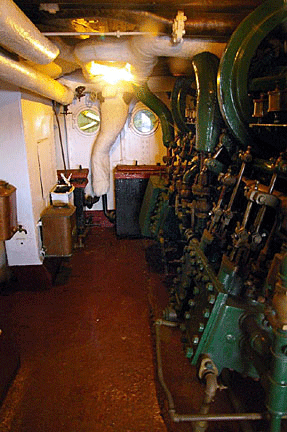 Vertical
reciprocating engines, a refrigeration system, and hydraulic
steering—all major technical achievements—distinguished the Olympia from
other warships of the time. The Allen Dense Air Ice Machine, still
located on the gun deck, turned steam into ice at 10 knots. The Olympia
could steam more than 6,000 nautical miles without refueling. But she
also was a racehorse, capable of 22 knots and a non-certified record of
26. Vertical
reciprocating engines, a refrigeration system, and hydraulic
steering—all major technical achievements—distinguished the Olympia from
other warships of the time. The Allen Dense Air Ice Machine, still
located on the gun deck, turned steam into ice at 10 knots. The Olympia
could steam more than 6,000 nautical miles without refueling. But she
also was a racehorse, capable of 22 knots and a non-certified record of
26.
The warship marked the transition between sail and steam. Two large
stacks showed she was a modern, coal-burning vessel. But she also had
two masts with crow’s nests and spars. Occasionally, her crerw deployed
her sails to save coal or keep the ship on course in heavy weather. And
as with sailing ships, the crew hung signal flags from the masts and
lookouts high in them could spot distant ships.
Her Duties at Sea
The Olympia sailed from San Francisco on August 25, 1895, to become
flagship of the Asiatic Squadron, replacing the USS Baltimore,
safeguarding American interests in Asia until 1899. On board were 33
officers and 378 enlisted men under the command of Captain John J. Read.
For three years, the squadron visited ports in Japan, China, and the
Philippines without incident. That changed shortly after the arrival of
Dewey as squadron commander on January 3,1898, with Captain Charles V.
Gridley relieving Read in command of the Olympia.
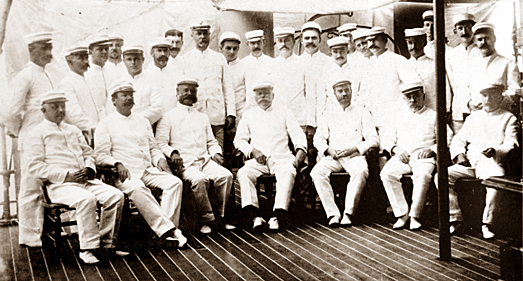
Her moment of glory came at the beginning of the Spanish American War in
1898, when she annihilated the Spanish fleet at Manila Bay under the
command of Commodore George Dewey.
Dewey steamed into Manila Bay on May 1, 1898, to face the Spanish
flotilla commanded by Rear Admiral Patricio Montojo y Pasarón. Montojo
had anchored his ships close to the shore and under the protection of
coastal artillery. However, the shore batteries along with the fleet
were to prove no match for Dewey’s squadron.
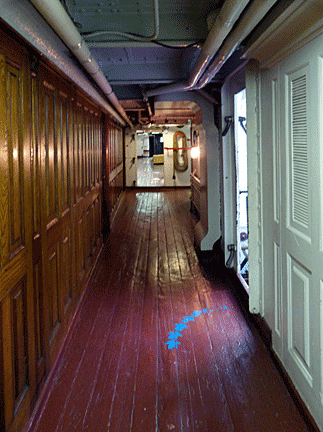 Dewey
must have felt confident. He ordered all the wooden desks and cabinets
removed from the ship, since they might produce splinters and endanger
the crew should she take a direct hit. The Commodore chose not to have
the fine wooden paneling inside the ship removed because they were part
of the ship’s character and thus were spared. Dewey
must have felt confident. He ordered all the wooden desks and cabinets
removed from the ship, since they might produce splinters and endanger
the crew should she take a direct hit. The Commodore chose not to have
the fine wooden paneling inside the ship removed because they were part
of the ship’s character and thus were spared.
After another year of service in the Philippines, she returned to the
U.S., and was featured prominently in national celebrations of victory
in that "lovely little war," as Teddy Roosevelt called it. After the
turn of the century, she served briefly with the Atlantic Squadron, but
with the introduction of Dreadnaught ships, she was soon de-activated
and used for little more than as a training ship for the Naval Academy,
and later a barracks ship.
She was re-activated during World War I and served with the Atlantic
Patrol Force. She was present for the coronation of the new Russian
czar, Nicholas II, in Vladivostok; then, at the start of the Bolshevik
Revolution, she was sent to Murmansk in 1918 to show support for the
White Russians. After the war, she did some "show the flag" cruising in
the Mediterranean and environs.
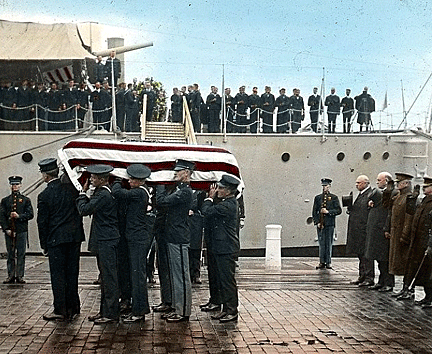 In
1921, she completed her final mission: bringing home the body of the
American Unknown Soldier from Le Havre, France, for burial in Arlington
National Cemetery. On Memorial Day, 1921, The U.S. Army exhumed four
unknown soldiers from four World War I American cemeteries in France.
U.S. Army Sargeant Edward F. Younger, who had been wounded in combat,
was highly decorated for valor, and had received the Distinguished
Service Medal, selected the Unknown Soldier of World War I from four
identical caskets at the city hall in Chalons-sur-Marne, France, on
October 24, 1921. Sargeant Younger selected the unknown by placing a
spray of white roses on one of the caskets. He chose the third casket
from the left. The U.S. Army then transported the chosen unknown soldier
to the United States aboard the USS Olympia. In
1921, she completed her final mission: bringing home the body of the
American Unknown Soldier from Le Havre, France, for burial in Arlington
National Cemetery. On Memorial Day, 1921, The U.S. Army exhumed four
unknown soldiers from four World War I American cemeteries in France.
U.S. Army Sargeant Edward F. Younger, who had been wounded in combat,
was highly decorated for valor, and had received the Distinguished
Service Medal, selected the Unknown Soldier of World War I from four
identical caskets at the city hall in Chalons-sur-Marne, France, on
October 24, 1921. Sargeant Younger selected the unknown by placing a
spray of white roses on one of the caskets. He chose the third casket
from the left. The U.S. Army then transported the chosen unknown soldier
to the United States aboard the USS Olympia.
From Warship to Tourist Attraction
Decommissioned in the Philadelphia Navy Yard in 1922, the once super
ship slipped into anonymity. In 1925 Washington politicians and American
Legionnaires blocked Navy
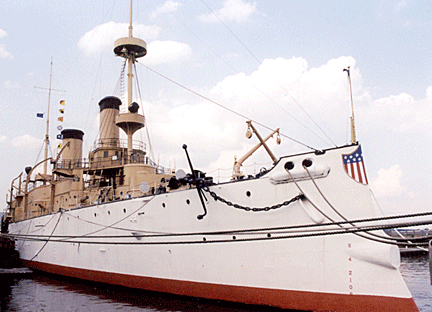 attempts
to scrap or sell the vessel. Two proposals to make her a permanent
shrine failed—one to embed her in concrete in the Potomac off the
capital, and another to do the same in Washington State. In 1942
President Franklin D. Roosevelt ordered the ship’s permanent
preservation. Twelve years later, Congress decided to dispose of all
historic ships except the USS Constitution. When the Navy announced it
sought some group willing to spend $650,000 to “restore and make a
public memorial of the warship Olympia,” civic-minded citizens in
Philadelphia put up the money to return her to 1898 form and add her to
the city’s riverfront as a tourist attraction. attempts
to scrap or sell the vessel. Two proposals to make her a permanent
shrine failed—one to embed her in concrete in the Potomac off the
capital, and another to do the same in Washington State. In 1942
President Franklin D. Roosevelt ordered the ship’s permanent
preservation. Twelve years later, Congress decided to dispose of all
historic ships except the USS Constitution. When the Navy announced it
sought some group willing to spend $650,000 to “restore and make a
public memorial of the warship Olympia,” civic-minded citizens in
Philadelphia put up the money to return her to 1898 form and add her to
the city’s riverfront as a tourist attraction.
She has since been declared a National Historic Landmark and a National
Historic Mechanical Engineering Landmark, and is listed in the National
Register of Historic Places.
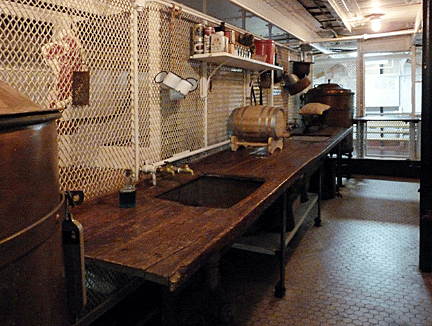 On
October 6, 1958, 13 months after the Navy transferred the ship’s title
to the Cruiser Olympia Association, she arrived at a temporary anchorage
along Philadelphia’s waterfront. That year, 88,000 paying visitors
toured the ship. That figure dipped to 77,574 two years later as
maintenance and program development costs mounted. The cruiser’s weather
decks suffered from the elements, and rust became a problem along the
ship’s waterline. On
October 6, 1958, 13 months after the Navy transferred the ship’s title
to the Cruiser Olympia Association, she arrived at a temporary anchorage
along Philadelphia’s waterfront. That year, 88,000 paying visitors
toured the ship. That figure dipped to 77,574 two years later as
maintenance and program development costs mounted. The cruiser’s weather
decks suffered from the elements, and rust became a problem along the
ship’s waterline.
On New Year’s Day of 1996, the Independence Seaport Museum, itself in
the midst of a $10 million renovation, took over the maintenance of the
USS Olympia. Money was tight. Until then, the Olympia teetered between
salvation and destruction.
But many efforts to maintain the ship have failed. In 2010, a local
campaign to raise the $20 million to tow Olympia to dry dock and restore
her hull fell far short of its goal.
Activating history
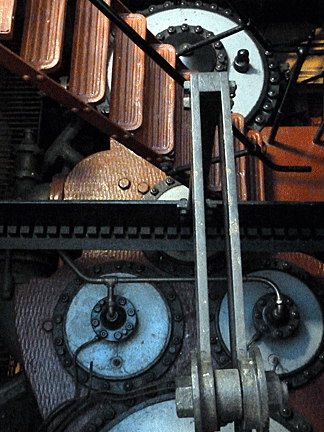 The
primary goal of the Independence Seaport Museum is to get things on the
ship in working order. As the effort grows to raise funds for the basic
repairs to the ship, restoration of other spaces continues in order to
increase interest and accessibility to her. Early projects included
polishing up the officers’ quarters and recreating the brig, the ship’s
jail. The
primary goal of the Independence Seaport Museum is to get things on the
ship in working order. As the effort grows to raise funds for the basic
repairs to the ship, restoration of other spaces continues in order to
increase interest and accessibility to her. Early projects included
polishing up the officers’ quarters and recreating the brig, the ship’s
jail.
The signal bridge on the top deck, where the ship communicated with the
rest of the fleet before the advent of radio, has been restored. Signal
flags were a form of coding that involved combinations of flags
representing combinations of letters. The museum also plans to open up
the engine room, which isn’t easily accessed through the tight spaces
and ladders.
The Ship’s Interior
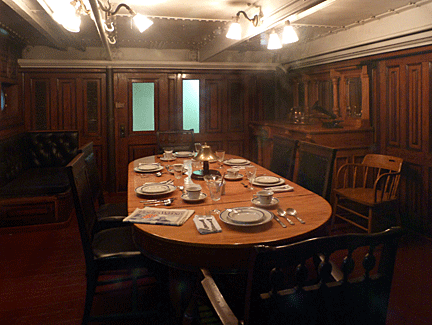 The
ship’s wooden main deck, painted a glossy magenta, leads to
well-maintained compartments for enlisted men, with worn mess tables and
hammocks as they appeared a century ago. The Victorian appointments in
the admiral’s and captain’s staterooms and quarters make them seem more
like an English manor house with a piano, porcelain bathtubs, fine china
cabinets, and oak paneling. The
ship’s wooden main deck, painted a glossy magenta, leads to
well-maintained compartments for enlisted men, with worn mess tables and
hammocks as they appeared a century ago. The Victorian appointments in
the admiral’s and captain’s staterooms and quarters make them seem more
like an English manor house with a piano, porcelain bathtubs, fine china
cabinets, and oak paneling.
The oak-paneled officers' cabins and wardroom, aft on the berth deck,
have been restored and maintained. These wooden bulkheads are all
latched in place, so that they could be struck below in battle.
The quarters for the enlisted men feature the original mess table
overhead, ditty box racks, hammock hooks, etc.
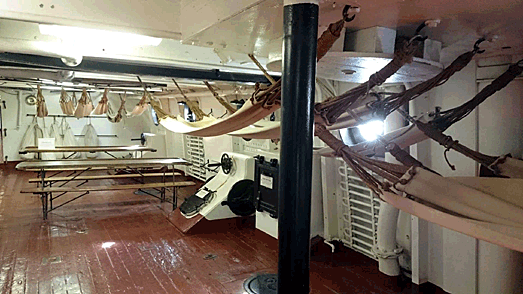
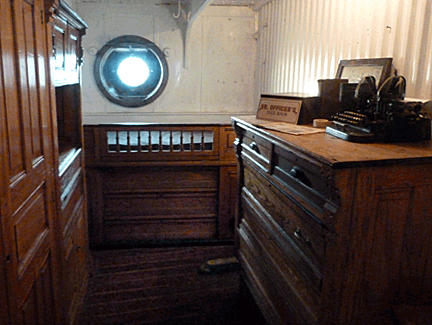 The
admiral's and captain's cabins feature extensive built-in furniture
including glass-fronted china cabinets. Period photographs show these
loaded with silver tea services, trays, loving cups, etc. The original
decor was reminiscent of a Victorian parlor. The
admiral's and captain's cabins feature extensive built-in furniture
including glass-fronted china cabinets. Period photographs show these
loaded with silver tea services, trays, loving cups, etc. The original
decor was reminiscent of a Victorian parlor.
In 2014 the museum began a series of interim steps to preserve the ship
while efforts for a major refit could be determined. Of course, Mother
Nature hasn’t helped matters in recent years. Both Hurricane Sandy in
2012 and the extreme weather in the winter of 2013-2014 put added stress
on the vessel. But the Olympia is a survivor. Long may her signal flags
wave.
<
More Special Features
Next Article > |
